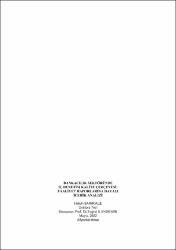| dc.contributor.advisor | Kandemir, Tuğrul | |
| dc.contributor.author | Sarıkale, Hakan | |
| dc.date.accessioned | 2022-07-04T07:46:45Z | |
| dc.date.available | 2022-07-04T07:46:45Z | |
| dc.date.issued | 2022 | en_US |
| dc.date.submitted | 2022 | |
| dc.identifier.uri | https://hdl.handle.net/11630/10053 | |
| dc.description.abstract | Denetim kalitesinin değerlendirilmesi ve tanımı konusunda henüz kesin bir uzlaşı sağlanamamış olmakla birlikte çeşitli otoriteler ve akademisyenler tarafından yürütülen çalışmalar ile “denetim kalite çerçevesi” oluşturularak, denetim kalitesi göstergeleri belirlenmeye çalışılmaktadır. Ancak bu çalışmaların büyük bir çoğunluğu bağımsız denetimle ilgili olup, iç denetim kalite çerçevesine yönelik sınırlı sayıda çalışma bulunmaktadır. Bu çalışmada iç denetim kalitesi ve işleyişini değerlendirirken bankaların odaklandıkları hususları kavramsal olarak ortaya çıkarabilmek amacıyla, 6 mevduat bankasının (3 kamu ve 3 özel) 10 yıllık faaliyet raporlarında yer alan iç denetimle ilgili bölümlere içerik analizi yapılmıştır. Tespit edilen 54 kod literatürde önerilen “iç denetim kalite çerçevesi” perspektifiyle beş boyut (Girdi-süreç-çıktı-sonuç-dışsal faktörler) altında sınıflandırılmıştır. Böylece bankaların iç denetimi değerlendirirken üzerinde durdukları odaklar, iç denetim hakkında oldukça önemli ve güvenilir bilgiler veren faaliyet raporlarından tespit edilerek sistematik bir şekilde kavramsallaştırılıp analiz edilmiştir. Buna göre hem kamu bankaları ve hem de özel bankalar iç denetime ilişkin değerlendirmelerinde birbirine benzer şekilde ilk sırada iç denetim kalite çerçevesinin “süreç” boyutuna odaklanmaktadır. Son 10 yıllık dönemde süreç boyutu (denetim sürecindeki faaliyetler, yöntem ve yaklaşımlar) beş boyut içerisinde hep ilk sırada, girdi boyutu (denetim ekibi ve denetçinin nitelikleri) ise sürekli son sırada yer almıştır. Üzerinde en fazla durulan konular ise girdi boyutunda denetçi sayısı ve eğitim; süreç boyutunda risk odaklı denetim, merkezden denetim ve süreç denetimleri; çıktı boyutunda yönetime sunulan raporlar/toplantılar ve bulgu takibi; sonuç boyutunda doğru ve güvenilir bilgi sağlama ile önleyici/caydırıcı olma; dışsal boyutta ise yasal düzenlemeler ve organizasyonel yapı olmuştur. Ayrıca güncel birçok denetim yaklaşımının ülkemizdeki mevduat bankaları tarafından yakından takip edilmekte olduğu tespit edilmiştir. İç denetim kalite çerçevesi, denetim kalitesini etkileyebilecek unsurların tespiti ve kavramsallaştırılması açısından oldukça önemli olup, iç denetim kalitesi değerlendirmelerinde karşılaştırabilirlik, şeffaflık ve farkındalık sağlayacaktır. | en_US |
| dc.description.abstract | Although a definite consensus has not been reached on the evaluation and definition of audit quality, audit quality indicators are tried to be determined by creating an "audit quality framework" with the studies carried out by various authorities and academicians. However, most of these studies are related to external auditing, and there are limited studies on the internal audit quality framework. İn this study, in order to conceptually reveal the issues that banks focus on while evaluating the quality and functioning of internal auditing, a content analysis was conducted on the sections related to internal audit in the 10-year annual reports of 6 deposit banks (3 public and 3 private). The identified 54 codes were classified under five dimensions (input-process-output-outcome-external factors) with the perspective of the “internal audit quality framework” suggested in the literature. Thus, the focuses of the banks while evaluating the internal audit were determined from the annual reports, which give very important and reliable information about the internal audit, and they were systematically conceptualized and analyzed. Accordingly, both public banks and private banks focus on the "process" dimension of the internal audit quality framework in the first place in their evaluations on internal audit, similar to each other. İn the last 10 years, the process dimension (activities, methods and approaches in the audit process) has always been in the first place among the five dimensions, while the input dimension (qualifications of the audit team and the auditor) has always been in the last place. The most emphasized topics are as follows; (1) in the inputs; number of auditors and training, (2) in processes; risk-based auditing, remote auditing and process audits, (3) in the outputs; reports/meetings submitted to the management and follow-up of findings, (4) in the outcomes; providing accurate and reliable information and being a preventive/deterrent, (5) İn external factors; legal regulations and organizational structure. İn addition, it has been determined that many current audit approaches are closely followed by deposit banks in Turkey. The internal audit quality framework is very important in identifying and conceptualizing the factors that may affect audit quality and will provide comparability, transparency and awareness in internal audit quality assessments | en_US |
| dc.language.iso | tur | en_US |
| dc.publisher | Afyon Kocatepe Üniversitesi Sosyal Bilimler Enstitüsü | en_US |
| dc.rights | info:eu-repo/semantics/openAccess | en_US |
| dc.subject | İç Denetim | en_US |
| dc.subject | Kalite Çerçevesi | en_US |
| dc.subject | Denetim Kalitesi | en_US |
| dc.subject | Kalite Göstergeleri | en_US |
| dc.subject | Bankalarda Denetim | en_US |
| dc.subject | Denetim Kalitesi | en_US |
| dc.subject | Yeni Denetim | en_US |
| dc.subject | Denetim Yaklaşımları | en_US |
| dc.subject | İçerik Analizi | en_US |
| dc.title | Bankacılık sektöründe İç denetim kalite çerçevesi: Faaliyet raporlarına dayalı içerik analizi | en_US |
| dc.title.alternative | İnternal audit quality framework in the banking sector: A content analysis based on annual reports | en_US |
| dc.type | doctoralThesis | en_US |
| dc.department | Enstitüler, Sosyal Bilimler Enstitüsü, İşletme Ana Bilim Dalı | en_US |
| dc.relation.publicationcategory | Tez | en_US |
| dc.contributor.institutionauthor | Sarıkale, Hakan | |



















